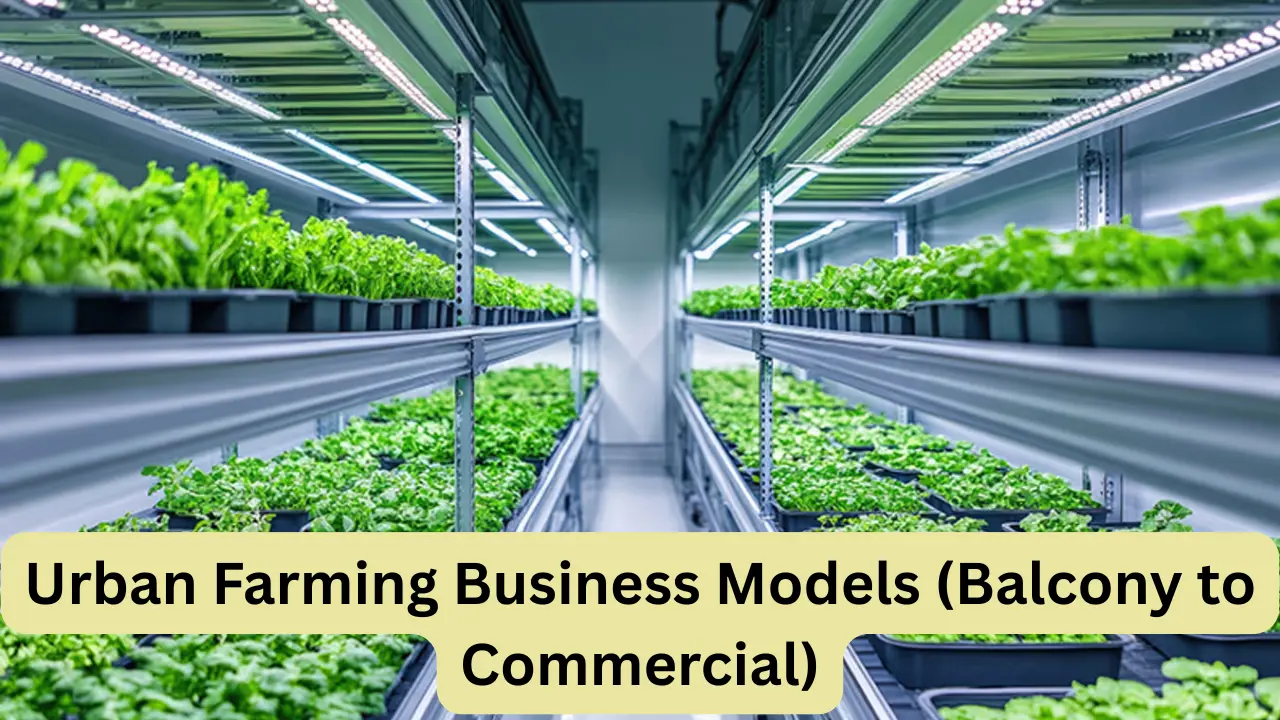Table of Contents
Urban Farming Business Models (Balcony to Commercial) are transforming how city dwellers contribute to food security, sustainability, and profitable entrepreneurship. From compact balcony gardens to full-fledged commercial greenhouses, these models offer eco-friendly solutions that cater to modern urban lifestyles. In this guide, we explore proven strategies to build a thriving, profitable urban farming venture — whether you’re a hobbyist or an aspiring agripreneur.
What are Urban Farming Business Models (Balcony to Commercial)?
Urban farming business models (balcony to commercial) refer to scalable agricultural approaches designed for city environments, ranging from small personal setups on balconies to large-scale commercial farms, that aim for sustainability, profit, and food production within urban settings.
🔑 Why Urban Farming Business Models (Balcony to Commercial) Are Gaining Popularity
Today’s urban farmers are responding to challenges such as rising food costs, environmental concerns, and limited rural farmland. Urban farming business models (balcony to commercial) offer:
- ✅ Efficient use of small spaces
- ✅ Reduced carbon footprint due to local production
- ✅ Fresh, organic produce for personal or commercial use
- ✅ New income streams for city-based entrepreneurs
Related post: Top 9 Rare but Profitable Agriculture Businesses in India
🌱 5 Ultimate Urban Farming Business Models (Balcony to Commercial)
1️⃣ Balcony Container Gardening
Perfect for apartment dwellers, this model uses pots, containers, and vertical racks to grow herbs, leafy greens, and even small fruits on balconies.
- 🌿 Low investment and easy to start
- 🌿 Ideal for personal use or selling to neighbors
- 🌿 Minimal maintenance with drip irrigation or self-watering pots
2️⃣ Vertical Hydroponic Systems
A space-efficient solution that uses water-based nutrient systems to grow crops vertically. These models are highly productive and eco-friendly.
| Feature | Benefit |
|---|---|
| Water usage | Uses 90% less water than soil farming |
| Yield | Higher yield per square foot |
| Setup cost | Moderate to high, depending on scale |
3️⃣ Rooftop Organic Farms
This model turns unused rooftop space into productive farms. Ideal for communities, restaurants, or schools.
- 🌻 Produces vegetables, fruits, and herbs at scale
- 🌻 Can supply to local markets or restaurants
- 🌻 Enhances urban biodiversity and reduces heat islands
Related post: Top 7 Rewarding Government Subsidy for Organic Farming Business in India
4️⃣ Indoor Microgreens Farming
Growing microgreens indoors under LED lights is one of the most profitable urban farming business models (balcony to commercial).
- 🌱 Short growth cycles (7-21 days)
- 🌱 High demand in premium restaurants and health-conscious markets
- 🌱 Compact setup fits inside homes, garages, or small commercial spaces
5️⃣ Commercial Greenhouse Farming
The most advanced of urban farming business models. Greenhouses allow year-round production using controlled environments.
- 🌿 Suitable for high-value crops (e.g., tomatoes, cucumbers, exotic herbs)
- 🌿 Scalable to meet city-wide demand
- 🌿 Potential to integrate aquaponics or aeroponics
💡 How to Choose the Right Urban Farming Business Model
Consider these factors before starting:
- 🔢 Space availability — Balcony, rooftop, or dedicated commercial space?
- 🔢 Budget — From low-cost containers to high-tech greenhouses.
- 🔢 Market demand — What do your local customers want?
- 🔢 Skill level — Are you ready for complex hydroponics or prefer simple soil farming?
📊 Profit Potential of Urban Farming Business Models (Balcony to Commercial)
| Model | Estimated Monthly Earnings (₹) | Initial Investment (₹) |
|---|---|---|
| Balcony Gardening | ₹2,000 – ₹10,000 | ₹5,000 – ₹20,000 |
| Vertical Hydroponics | ₹15,000 – ₹50,000 | ₹30,000 – ₹1,50,000 |
| Rooftop Organic Farm | ₹20,000 – ₹60,000 | ₹50,000 – ₹2,00,000 |
| Microgreens | ₹10,000 – ₹40,000 | ₹10,000 – ₹50,000 |
| Commercial Greenhouse | ₹50,000 – ₹2,00,000 | ₹2,00,000+ |
🎯 Final Tips for Success in Urban Farming Business Models (Balcony to Commercial)
- ✅ Focus on niche crops that have local demand.
- ✅ Embrace technology — IoT sensors, apps for monitoring.
- ✅ Market smartly — build community ties, join farmers’ markets, sell online.
- ✅ Stay compliant — follow local food safety and zoning laws.
Related post: Top 7 Smart Ways to Avail ₹25 Lakh PMEGP Subsidy Scheme for a Successful Business Launch
✅ Conclusion
Urban farming business models (balcony to commercial) are not just trends — they are sustainable, profitable solutions for a greener future. Whether you’re nurturing herbs on your balcony or managing a high-tech greenhouse, urban farming offers exciting opportunities for city-based entrepreneurs who want to make a difference. Choose your model, plan smartly, and contribute to a thriving urban ecosystem!
❓ FAQs on Urban Farming Business Models (Balcony to Commercial)
What is the most profitable urban farming model?
Commercial greenhouse farming often generates the highest profits due to scalability and year-round production capabilities.
Can I start urban farming on a small balcony?
Yes! Balcony container gardening or vertical systems are ideal for small spaces and can yield herbs, greens, and small fruits.
How much investment is required for a rooftop farm?
Typically ₹50,000 to ₹2,00,000, depending on the size, soil requirements, and irrigation setup.
Is urban farming eco-friendly?
Absolutely. Urban farming reduces food miles, supports biodiversity, and promotes sustainable city living.
Do I need special permission for commercial urban farming?
It depends on local regulations. Always check municipal zoning laws and food safety guidelines before starting.








It’s good
10000